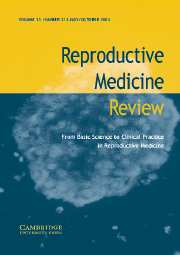Article contents
Oviductal cells and early conception
Published online by Cambridge University Press: 03 June 2009
Extract
The ability to bypass the oviduct by fertilizing human oocytes in vitro and then transferring the ensuing embryos into the uterine environment to produce pregnancies that can be carried to term (assisted reproductive technology, ART) has made the real functional significance of the fallopian tube come under debate. The question has been raised as to whether the oviduct is a simple conduit, providing for the transport of gametes and embryos, or whether it has any functional relevance to early conception. In the field of ART, some reports claim that transfer of embryos either to the uterus or to the oviduct yield similar results, while a greater amount of evidence confirms that tubal transfers are associated with higher pregnancy and take home baby rates, suggesting that unknown factors in the oviduct favour fertilization and embryo viability. This review attempts to provide some answers to questions about the role of oviductal cells in vivo during early conception and in vitro in the field of ART.
- Type
- Articles
- Information
- Copyright
- Copyright © Cambridge University Press 1995
References
- 1
- Cited by


